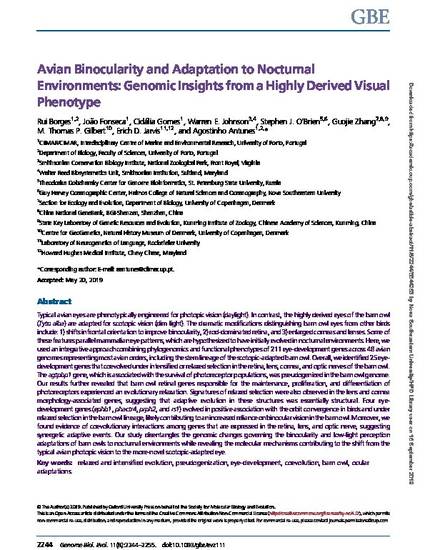
- Relaxed and intensified evolution,
- Pseudogenization,
- Eye-development,
- Coevolution,
- Barn owl,
- Ocular adaptations
- Biology and
- Life Sciences
Typical avian eyes are phenotypically engineered for photopic vision (daylight). In contrast, the highly derived eyes of the barn owl (Tyto alba) are adapted for scotopic vision (dim light). The dramatic modifications distinguishing barn owl eyes from other birds include: 1) shifts in frontal orientation to improve binocularity, 2) rod-dominated retina, and 3) enlarged corneas and lenses. Some of these features parallel mammalian eye patterns, which are hypothesized to have initially evolved in nocturnal environments. Here, we used an integrative approach combining phylogenomics and functional phenotypes of 211 eye-development genes across 48 avian genomes representing most avian orders, including the stem lineage of the scotopic-adapted barn owl. Overall, we identified 25 eye-development genes that coevolved under intensified or relaxed selection in the retina, lens, cornea, and optic nerves of the barn owl. The agtpbp1 gene, which is associated with the survival of photoreceptor populations, was pseudogenized in the barn owl genome. Our results further revealed that barn owl retinal genes responsible for the maintenance, proliferation, and differentiation of photoreceptors experienced an evolutionary relaxation. Signatures of relaxed selection were also observed in the lens and cornea morphology-associated genes, suggesting that adaptive evolution in these structures was essentially structural. Four eye-development genes (ephb1, phactr4, prph2, and rs1) evolved in positive association with the orbit convergence in birds and under relaxed selection in the barn owl lineage, likely contributing to an increased reliance on binocular vision in the barn owl. Moreover, we found evidence of coevolutionary interactions among genes that are expressed in the retina, lens, and optic nerve, suggesting synergetic adaptive events. Our study disentangles the genomic changes governing the binocularity and low-light perception adaptations of barn owls to nocturnal environments while revealing the molecular mechanisms contributing to the shift from the typical avian photopic vision to the more-novel scotopic-adapted eye.
Available at: http://works.bepress.com/stephen-obrien/708/

©The Author(s) 2019. Published by Oxford University Press on behalf of the Society for Molecular Biology and Evolution. This is an Open Access article distributed under the terms of the Creative Commons Attribution Non-Commercial License (http://creativecommons.org/licenses/by-nc/4.0/), which permits non-commercial re-use, distribution, and reproduction in any medium, provided the original work is properly cited.